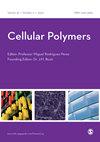碳纳米管对生物多元醇基聚氨酯泡沫性能的影响
IF 1.3
4区 医学
Q4 MATERIALS SCIENCE, BIOMATERIALS
引用次数: 1
摘要
以甘蔗渣和稻壳为原料进行液化,得到生物多元醇。测定了液体产品的酸和羟基值,以估计其多元醇值。将制备的生物多元醇与工业多元醇混合制备聚氨酯泡沫(PU)。为了研究生物多元醇对聚氨酯泡沫性能的影响,采用了不同比例的生物多元醇与商品多元醇。结果表明,随着生物多元醇含量的增加,聚氨酯泡沫的密度增大,发泡时间延长。计算的异氰酸酯指数表明,甘蔗渣多元醇可用于生产柔性泡沫,稻壳可用于生产刚性泡沫。随着生物多元醇含量的增加,发泡次数和全升次数增加。制备的泡沫的傅里叶红外光谱(FTIR)显示了与PU泡沫相关的特征峰。形态学研究采用扫描电镜(SEM)进行。热导率试验证明,合成的PU泡沫可以作为绝缘材料。此外,还在多元醇中掺入碳纳米管(CNTs)制备了聚氨酯泡沫。比较了含碳纳米管和不含碳纳米管的聚氨酯泡沫的密度、导热系数和SEM分析。本文章由计算机程序翻译,如有差异,请以英文原文为准。
Influence of carbon nanotubes on the properties of biopolyol based polyurethane foams
Biopolyols were obtained from liquefaction of sugarcane bagasse and rice husk. Acid and hydroxyl numbers were determined for estimating the polyol value of the liquid products. These prepared biopolyols were mixed with the commercial polyol for the preparation of polyurethane foam (PU). To study the effects of biopolyol on properties of PU foam, various ratios of biopolyol to commercial polyol were used. It was observed that the density and foaming time of the PU foam increases with the increase in biopolyol content. The calculated Isocyanate index showed that sugarcane bagasse polyol can be used to make flexible foam and that rice husk can be used to make rigid foam. Foaming times and full rise times increased with increase in the biopolyol content. The Fourier-transform infrared spectroscopy (FTIR) spectra of prepared foams showed the characteristic peaks related to PU foam. The morphological studies were carried out using scanning electron microscopy (SEM). Thermal conductivity tests proved that the synthesized PU foams can be used as insulating materials. Further, PU foams were also prepared with the incorporation of carbon nanotubes (CNTs) in the polyol. The densities, thermal conductivities and SEM analysis of PU foams with and without carbon nanotubes were compared.
求助全文
通过发布文献求助,成功后即可免费获取论文全文。
去求助
来源期刊

Cellular Polymers
工程技术-材料科学:生物材料
CiteScore
3.10
自引率
0.00%
发文量
9
审稿时长
3 months
期刊介绍:
Cellular Polymers is concerned primarily with the science of foamed materials, the technology and state of the art for processing and fabricating, the engineering techniques and principles of the machines used to produce them economically, and their applications in varied and wide ranging uses where they are making an increasingly valuable contribution.
Potential problems for the industry are also covered, including fire performance of materials, CFC-replacement technology, recycling and environmental legislation. Reviews of technical and commercial advances in the manufacturing and application technologies are also included.
Cellular Polymers covers these and other related topics and also pays particular attention to the ways in which the science and technology of cellular polymers is being developed throughout the world.
 求助内容:
求助内容: 应助结果提醒方式:
应助结果提醒方式:


